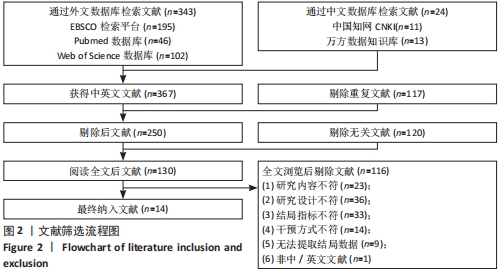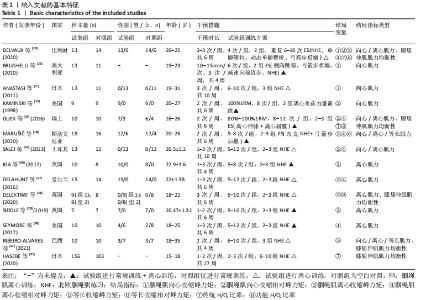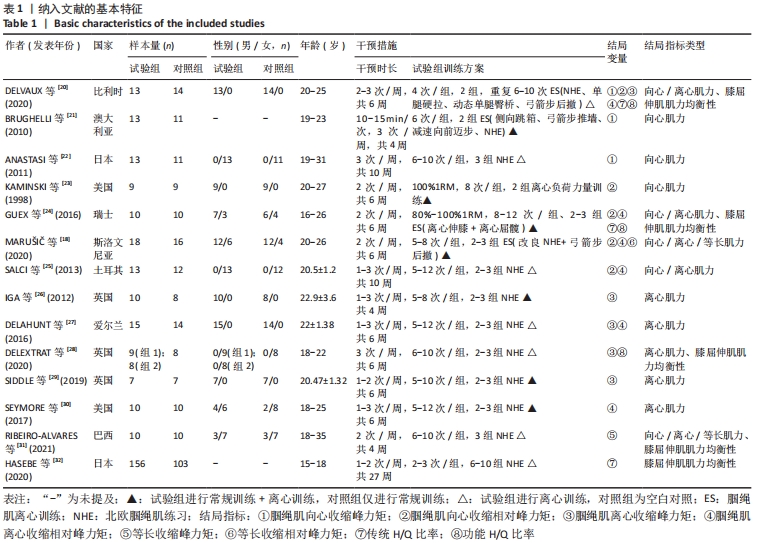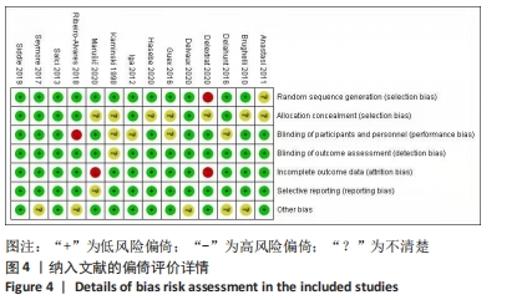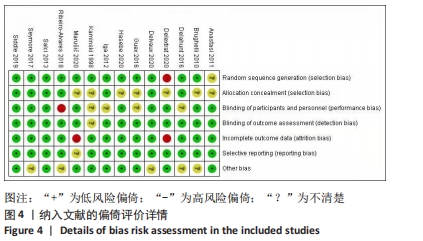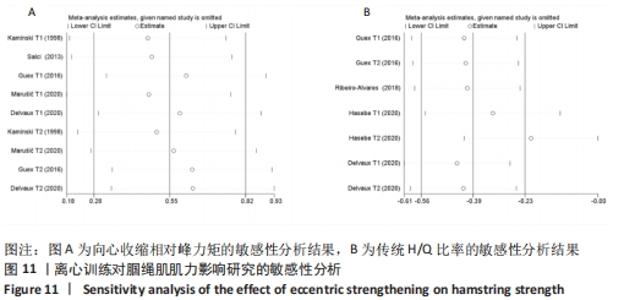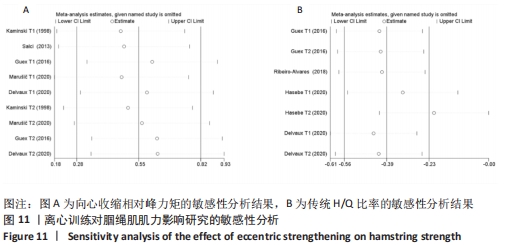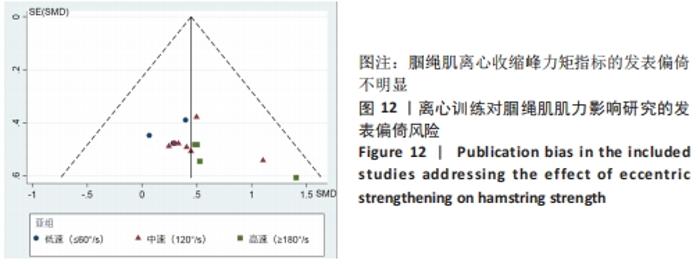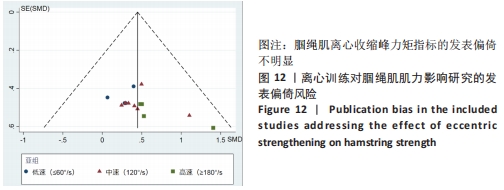Chinese Journal of Tissue Engineering Research ›› 2022, Vol. 26 ›› Issue (29): 4749-4756.doi: 10.12307/2022.900
Effect of eccentric strengthening on hamstring strength: a Meta-analysis
Zheng Wei1, Sun Libing1, Xiong Yingzhe2, Zhang Yichi3, You Jing1, Huang Wenqi1, Guo Yanhua1, Liu Hongjun1
- 1Tianjin University of Sport, Tianjin 301617, China; 2Tsinghua University, Beijing 100084, China; 3Univerisy College London, London WC1N 1AX, UK
-
Received:2021-09-16Accepted:2021-10-19Online:2022-10-18Published:2022-03-28 -
Contact:Liu Hongjun, Professor, Master’s supervisor, Tianjin University of Sport, Tianjin 301617, China -
About author:Zheng Wei, PhD, Tianjin University of Sport, Tianjin 301617, China -
Supported by:Scientific Research Project of Tianjin Municipal Education Commission, No. 2020KJ101 (to ZW)
CLC Number:
Cite this article
Zheng Wei, Sun Libing, Xiong Yingzhe, Zhang Yichi, You Jing, Huang Wenqi, Guo Yanhua, Liu Hongjun. Effect of eccentric strengthening on hamstring strength: a Meta-analysis[J]. Chinese Journal of Tissue Engineering Research, 2022, 26(29): 4749-4756.
share this article
Add to citation manager EndNote|Reference Manager|ProCite|BibTeX|RefWorks
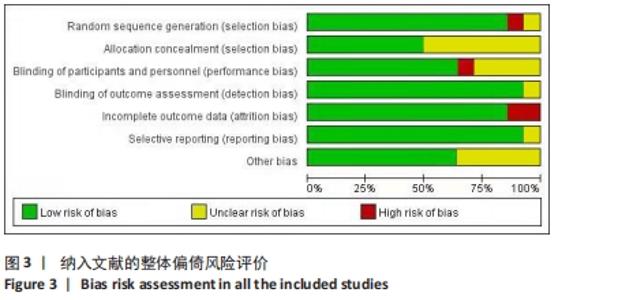
2.3 纳入文献质量评价结果 运用Review manager 5.3软件对纳入的14篇文献进行质量评价,结果见图3,4。评价条目包括选择偏倚(selection bias)、实施偏倚(performance bias)、测量偏倚(detection bias)、损耗偏倚(attrition bias)、报告偏倚(reporting bias)和其他偏倚(other bias),其中选择偏倚又细分为随机序列产生(random sequence generation)和分配隐藏(allocation concealment)。各有1篇文献分别在选择偏倚和实施偏倚方面存在高风险,另有2篇文献在失访偏倚方面存在高风险。低偏倚风险(low risk of bias)记1分,高偏倚风险(high risk of bias)和偏倚风险不详(unclear risk of bias)记0分,所有纳入文献总分均≥4分,整体质量较高。 2.4 Meta分析结果 对纳入文献中腘绳肌向心收缩峰力矩及相对峰力矩、离心收缩峰力矩及相对峰力矩、等长收缩峰力矩及相对峰力矩、传统及功能H/Q比率等8项结局指标进行Meta分析。由于部分研究测试了不同组别或腘绳肌在低[≤60 (°)/s]、中[120 (°)/s]、高[≥180 (°)/s]角速度条件下的峰力矩,因此对同一项研究的不同试验数据用T1,T2···Tn表示。"
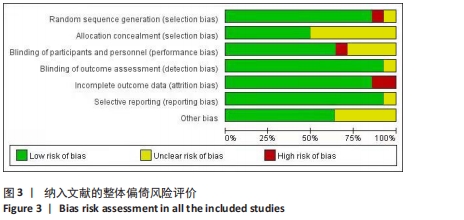
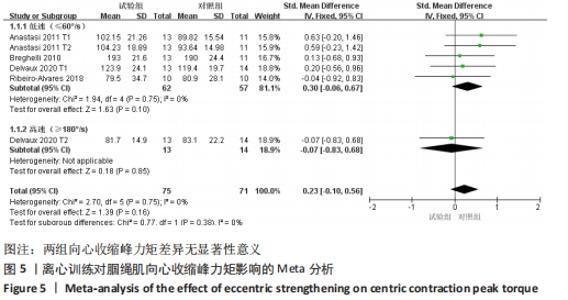
2.4.1 对腘绳肌向心肌力的影响 (1)对向心收缩峰力矩的影响:向心收缩峰力矩和相对峰力矩是利用等速肌力测试仪器计算出腘绳肌在某一测试角度下进行向心收缩的最大力矩值,反映了腘绳肌在向心收缩过程中的最大力量[33]。共有4篇文献报道了6项离心训练后腘绳肌向心收缩峰力矩差异的随机对照试验[20-22,31],试验组和对照组的合并样本量分别为75和71,各研究结果之间无异质性(I2=0%,P=0.75),见图5。采用固定效应模型进行分析,结果显示,与对照组相比,虽然试验组受试者的腘绳肌向心收缩峰力矩在离心训练后有所增加,但差异无显著性意义(SMD=0.23,95%CI:-0.10-0.56,P > 0.05)。根据等速肌力测试的不同角速度进行亚组分析后发现,仅有1篇文献在240 (°)/s角速度下进行测定[20],其余3项研究的5个随机对照试验均在≤60 (°)/s低速条件下完成向心肌力测试[21-22,31],后者的腘绳肌向心收缩峰力矩在离心训练后的组间差异同样不存在显著性意义(SMD=0.30,95%CI:-0.06-0.67,P > 0.05)。"
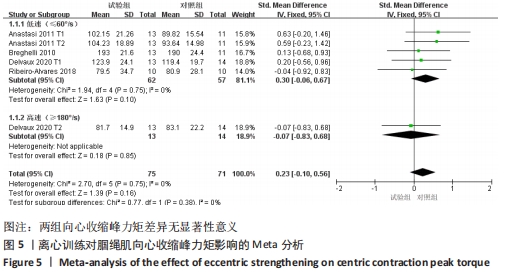
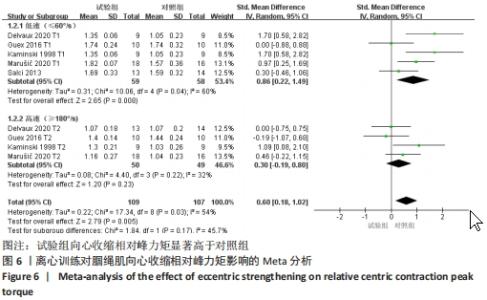
(2)对向心收缩相对峰力矩的影响:为排除受试者体质量对腘绳肌向心收缩最大肌力的影响,另对腘绳肌向心收缩相对峰力矩(峰力矩/体质量)进行了Meta分析,共涉及5篇文献的9项试验[18,20,23-25],试验组和对照组的合并样本量分别为109和107,各合并研究的I2=54%,P=0.03,说明文献之间具有中度异质性[34],见图6。采取随机效应模型进行Meta分析,结果显示在离心训练结束后,试验组的向心收缩相对峰力矩高于对照组,且2组该指标之间差异具有显著性意义(SMD=0.60,95%CI:0.18-1.02,P < 0.01)。亚组分析结果显示,60 (°)/s角速度时的向心收缩相对峰力矩在离心训练后显著增加,且与对照组差异相比具有显著性意义(SMD=0.86,95%CI:0.22-1.49,P < 0.01);180 (°)/s或240 (°)/s时的该指标在离心训练后有所提升,但较对照组差异无显著性意义(SMD=0.30,95%CI:-0.19-0.80,P > 0.05)。"
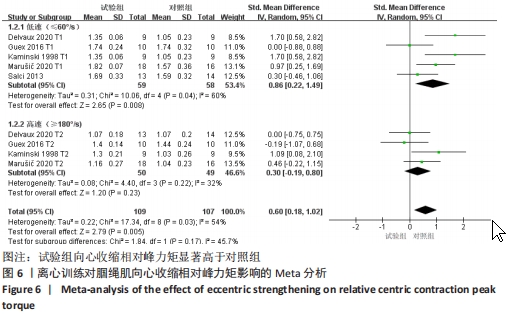
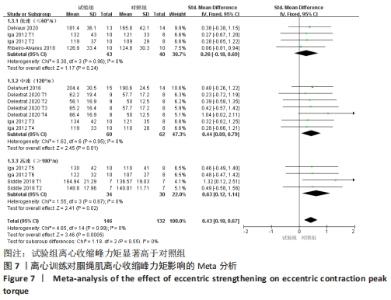
2.4.2 对腘绳肌离心肌力的影响 (1)对离心收缩峰力矩的影响:离心收缩峰力矩和相对峰力矩是利用等速肌力测试仪器计算出腘绳肌在某一测试角度下进行离心收缩的最大力矩值,反映了腘绳肌在离心收缩过程中的最大力量[33]。从图7可看出,有关腘绳肌离心收缩峰力矩的纳入文献共涉及6项研究和15个随机对照试验[20,26-29,31],试验组和对照组的合并样本量分别为146和132。各合并研究之间无异质性(I2=0%,P=0.99),故采用固定效应模型计算合并效应量,结果显示与对照组相比,离心训练对腘绳肌离心收缩峰力矩的提高有显著性效果(SMD=0.43,95%CI:0.18-0.67,P < 0.001)。亚组分析后发现,低角速度时的离心收缩峰力矩虽在离心训练后有所提高,但较对照组差异无显著性意义(SMD=0.26,95%CI:-0.18-0.69,P > 0.05);120 (°)/s角速度时腘绳肌离心收缩峰力矩在离心训练后明显增加,且与对照组差异有显著性意义(SMD=0.44,95%CI:0.09-0.79,P=0.01);在180 (°)/s和240 (°)/s条件下测得的该指标在离心训练后提升幅度最大,且与对照组差异具有显著性意义(SMD=0.63,95%CI:0.12-1.14,P < 0.05)。"


(2)对离心收缩相对峰力矩的影响:在纳入文献中,共有6篇文献的8项试验研究了离心训练对腘绳肌离心收缩相对峰力矩的影响[18,20,24-25,27,30]。结果表明,数据之间具有较小异质性(I2=47%,P=0.07)。采用固定效应模型进行分析后发现,与对照组比较,离心训练后腘绳肌离心收缩相对峰力矩无明显变化(SMD=0.24,95%CI:-0.04-0.51,P > 0.05),见图8。亚组分析结果显示,试验组低角速度时的离心收缩相对峰力矩在离心训练后有所增加,与对照组相比差异有显著性意义(SMD=0.46,95%CI:0.09-0.82,P < 0.05);而中等角速度时该指标虽有提升(SMD=0.07,95%CI:-0.50-0.63,P > 0.05),高速时该指标略有下降(SMD=-0.29, 95%CI:-0.96-0.39,P > 0.05),但较对照组差异均无显著性意义。"
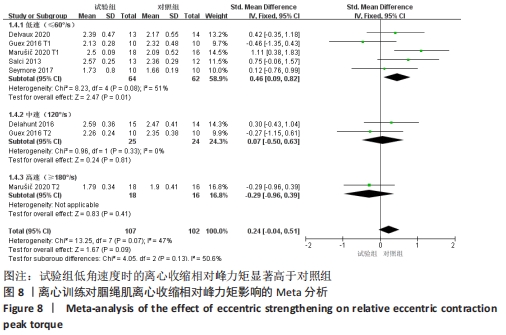
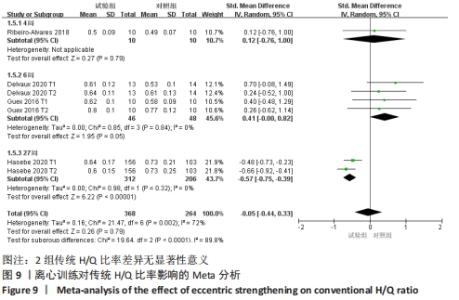
2.4.3 对腘绳肌等长肌力的影响 从表1中可以看出,结局指标为等长收缩峰力矩和相对峰力矩的纳入研究各有1项[18,31],结果显示在离心训练后,试验组的等长收缩峰力矩无显著改变,等长收缩相对峰力矩略有提高。考虑到纳入试验数量较少,且样本量较低,因此这2项结局指标并不适合进行Meta分析,可能会存在一定的偏倚,同时体现出未来需要更多关注离心训练对腘绳肌等长肌力影响的研究。 2.4.4 对膝屈伸肌肌力均衡性的影响 (1)对传统H/Q比率的影响:传统H/Q比率是指腘绳肌向心收缩峰力矩与股四头肌向心收缩峰力矩的比值,能够反映膝关节屈伸肌群肌力的均衡性,对诊断膝关节周围损伤具有一定的参考价值[35]。从图9可以看出,有关该结局指标的纳入试验为4项研究的7个随机对照试验[20,24,31-32],试验组和对照组合并样本量分别为368和264。各数据之间具有较高异质性(I2=72%,P < 0.01)。采用随机效应模型进行合并效应值计算,结果表明腘绳肌离心训练组与对照组相比,对传统H/Q比率的改善并无显著性作用(SMD=-0.05,95%CI:-0.44-0.33,P > 0.05)。根据离心训练干预时长进行亚组分析,结果显示,试验组传统H/Q比率在4-6周离心训练后有所提高,但差异不具有显著性意义,而1篇文献的2项研究结果显示[32],该指标在27周离心训练后有所下降,且与对照组差异有显著性意义(SMD=-0.57,95%CI:-0.75至-0.39,P < 0.000 01)。回顾该文献时发现研究者采用手持测力计测量腘绳肌和股四头肌肌力,而传统H/Q比率的其他相关文献均采用等速肌力测试仪器进行评定,因此可能存在一定的误差。"
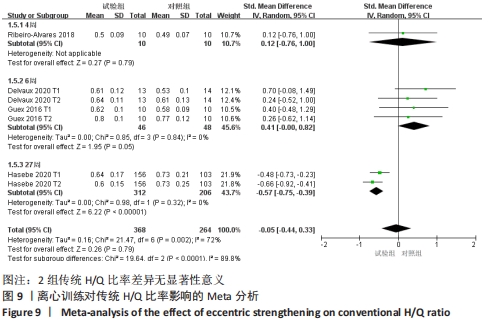
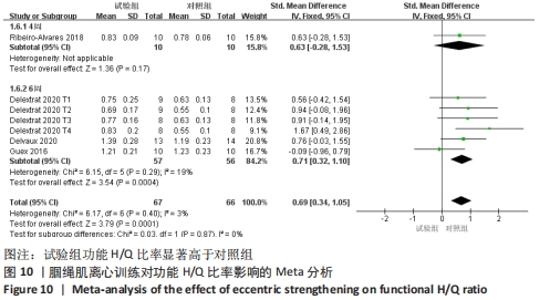
(2)对功能H/Q比率的影响:功能H/Q比率是指腘绳肌离心收缩峰力矩与股四头肌向心收缩峰力矩的比值[36]。由于腘绳肌损伤大多发生于腘绳肌进行最大离心收缩阶段,因此该指标能更加客观地反映运动过程中膝屈伸肌群的收缩模式,因此对腘绳肌拉伤及前交叉韧带损伤等具有更加客观的诊断价值[37]。有4篇纳入文献中7项随机对照试验涉及该结局指标的研究[20,24,28,31],试验组和对照组合并样本量分别为67和66。数据之间异质性较低(I2=3%,P=0.40),见图10。采用固定效应模型进行分析后发现,试验组在进行腘绳肌离心训练后能够明显提高功能H/Q比率(SMD=0.69,95%CI:0.34-1.05,P=0.000 1)。根据不同训练时长进行亚组分析后发现,6周离心训练对功能H/Q比率的提升效果更加显著,与对照组相比,差异具有显著性意义(SMD=0.71,95%CI:0.32-1.10,P < 0.001)。"
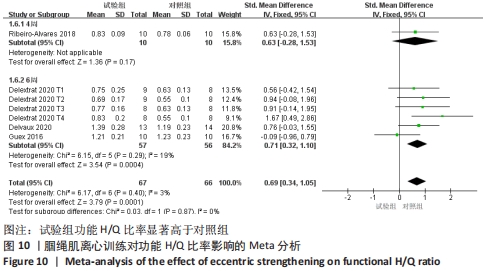
| [1] FREEMAN BW, TALPEY SW, JAMES LP, et al. Sprinting and Hamstring Strain Injury: Beliefs and Practices of Professional Physical Performance Coaches in Australian Football. Phys Ther Sport. 2021;48:12-19. [2] ZACHAZEWSKI J, SILVERS H, LI B, et al. Prevalence of Hamstring Injuries in Summer League Baseball Players. Int J Sports Phys Ther. 2019;14(6): 885. [3] ROE M, MURPHY JC, GISSANE C, et al. Hamstring Injuries in Elite Gaelic Football: An 8-Year Investigation to Identify Injury Rates, Time-Loss Patterns and Players at Increased Risk. Br J Sports Med. 2018; 52(15):982-988. [4] EDUARD B, OLEG T, MIKHAIL B, et al. The Prevalence of Non-contact Muscle Injuries of the Lower Limb in Professional Soccer Players who Perform Salah Regularly: A Retrospective Cohort Study. J Orthop Surg Res. 2020;15(1):1-6. [5] MALLIAROPOULOS N, BIKOS G, MEKE M, et al. Higher Frequency of Hamstring Injuries in Elite Track and Field Athletes who Had a Previous Injury to the Ankle-a 17 Years Observational Cohort Study. J Foot Ankle Res. 2018;11(1):1-8. [6] OKOROHA KR, CONTE S, MAKHNI EC, et al. Hamstring Injury Trends in Major and Minor League Baseball: Epidemiological Findings From the Major League Baseball Health and Injury Tracking System. Orthop J Sports Med. 2019;7(7):1-7. [7] BUCKTHORPE M, WRIGHT S, BRUC-LOW S, et al. Recommendations for Hamstring Injury Prevention in Elite Football: Translating Research into Practice. Br J Sports Med. 2019;53(7):449-456. [8] HUYGAERTS S, COS F, COHEN DD, et al. Mechanisms of Hamstring Strain Injury: Interactions between Fatigue, Muscle Activation and Function. Sports (Basel). 2020;8(5):65. [9] ERTELT T, GRONWALD T. Hamstring Injury Risk Factors in Elite Sports: The Role of Muscle Geometry and Function. Acta Physiol. 2019;227(1):e13253-e13253. [10] 杜建平,任薇,夏能能,等.等速肌力训练对改善膝骨关节炎肌肉功能的Meta分析[J].中国康复,2020,35(11):594-599. [11] Kenneally-Dabrowski CJB, Brown NAT, Lai AKM, et al. Late Swing or Early Stance? A Narrative Review of Hamstring Injury Mechanisms during High-Speed Running. Scand J Med Sci Sports. 2019;29(8):1083-1091. [12] 卢志泉,夏正亮,李玉章,等.肌肉力量的神经生物力学基础及诊断[J].上海体育学院学报,2019,43(3):113-120,126. [13] 谭恺,张春合,吕海龙. Nordic Hamstring跪姿前倾离心训练的生理效应及其对腘绳肌拉伤的预防效果[J]. 中国运动医学杂志,2019,38(7):601-610. [14] ABDEL-AZIEM AA, SOLIMAN ES, ABDELRAOUF OR. Isokinetic Peak Torque and Flexibility Changes of the Hamstring Muscles after Eccentric Training: Trained versus Untrained Subjects. Acta Orthop Traumatol Turc. 2018;52(4):308-314. [15] HEGYI A, PÉTER A, FINNI T, et al. Region-Dependent Hamstrings Activity in Nordic Hamstring Exercise and Stiff-Leg Deadlift Defined with High-Density Electromyography. Scand J Med Sci Sports. 2018;28(3):992-1000. [16] VANGSGAARD S, TAYLOR JL, HANSEN EA, et al. Changes in H Reflex and Neuromechanical Properties of the Trapezius Muscle after 5 weeks of Eccentric Training: A Randomized Controlled Trial. J Appl Physiol (1985). 2014; 116(12):1623-1631. [17] TØIEN T, PEDERSEN HAGLO H, UNHJEM R, et al. Maximal Strength Training: the Impact of Eccentric Overload. J Neurophysiol. 2018; 120(6):2868-2876. [18] MARUŠIČ J, VATOVEC R, MARKOVIĆ G, et al. Effects of Eccentric Training at Long-Muscle Length on Architectural and Functional Characteristics of the Hamstrings. Scand J Med Sci Sports. 2020;30(11):2130-2142. [19] 谷鸿秋,王杨,李卫.Cochrane偏倚风险评估工具在随机对照研究Meta分析中的应用[J].中国循环杂志,2014,29(2):147-148. [20] DELVAUX F, SCHWARTZ C, DECREQUY T, et al. Influence of a Field Hamstring Eccentric Strengthening on Muscle Strength and Flexibility. Int J Sports Med. 2020;41(4): 233-241. [21] BRUGHELLI M, MENDIGUCHIA J, NOSAKA K, et al. Effects of Eccentric Exercise on Optimum Length of the Knee Flexors and Extensors during the Preseason in Professional Soccer Players. Phys Ther Sport. 2010;11(2):50-55. [22] ANASTASI SM, HAMZEH MAL. Does the Eccentric Nordic Hamstring Exercise Have an Effect on Isokinetic Muscle Strength Imbalance and Dynamic Jumping Performance in Female Rugby Union Players?. Isokinet Exerc Sci. 2011; 19(4):251-260. [23] Kaminski TW, Wabbersen CV, Murphy RM. Concentric versus Enhanced Eccentric Hamstring Strength Training: Clinical Implications. J Athl Train. 1998;33(3):216-221. [24] GUEX KJ, LUGRIN V, BORLOZ S, et al. Influence on Strength and Flexibility of a Swing Phase-Specific Hamstring Eccentric Program in Sprinters’ General Preparation. J Strength Cond Res. 2016;30(2):525-532. [25] SALCI Y, YILDIRIM A, CELIK O, et al. The Effects of Eccentric Hamstring Training on Lower Extremity Strength and Landing Kinetics in Recreational Female Athletes. Isokinet Exerc Sci. 2013;21(1):11-18. [26] IGA J, FRYER CS, DEIGHAN M, et al. ‘Nordic’ Hamstrings Exercise Engagement Characteristics and Training Responses. Int J Sports Med. 2012;33(12):1000-1004. [27] DELAHUNT E, McGROARTY M, De VITO G, et al. Nordic Hamstring Exercise Training Alters Knee Joint Kinematics and Hamstring Activation Patterns in Young Men. Eur J Appl Physiol. 2016;116(4):663-672. [28] DELEXTRAT A, BATEMAN J, ROSS C, et al. Changes in Torque-Angle Profiles of the Hamstrings and Hamstrings-to-Quadriceps Ratio after Two Hamstring Strengthening Exercise Interventions in Female Hockey Players. J Strength Cond Res. 2020;34(2):396-405. [29] SIDDLE J, GREIG M, WEAVER K, et al. Acute Adaptations and Subsequent Preservation of Strength and Speed Measures Following a Nordic Hamstring Curl Intervention: A Randomised Controlled Trial. J Sports Sci. 2019;37(8):911-920. [30] SEYMORE KD, DOMIRE ZJ, DEVITA P, et al. The Effect of Nordic Hamstring Strength Training on Muscle Architecture, Stiffness, and Strength. Eur J Appl Physiol. 2017;117(5):943-953. [31] RIBEIRO-ALVARES JB, OLIVEIRA GDS, De LIMA-E-SILVA FX, et al. Eccentric Knee Flexor Strength of Professional Football Players with and without Hamstring Injury in the Prior Season. Eur J Sport Sci. 2021;21(1):131-139. [32] HASEBE Y, AKASAKA K, OTSUDO T, et al. Effects of Nordic Hamstring Exercise on Hamstring Injuries in High School Soccer Players: A Randomized Controlled Trial. Int J Sports Med. 2020;41(3):154-160. [33] 尚玢,曹峰锐,陈静. 男子水球守门员膝、踝关节屈伸肌群等速肌力实验测量[J].太原理工大学学报,2019,50(1):135-140. [34] DEMETS DL. Methods for Combining Randomized Clinical Trials: Strengths and Limitations. Stat Med. 1987;6(3):341-34. [35] ROUIS M, COUDRAT L, JAAFAR H, et al. Assessment of Isokinetic Knee Strength in Elite Young Female Basketball Players: Correlation with Vertical Jump. J Sports Med Phys Fitness. 2015;55(12):1502-1508. [36] SUNDBY OH, GORELICK ML. Relationship Between Functional Hamstring: Quadriceps Ratios and Running Economy in Highly Trained and Recreational Female Runners. J Strength Cond Res. 2014;28(8):2214-2227. [37] 曹峰锐.“腘绳肌离心收缩力矩/股四头肌向心收缩力矩”在预防腘绳肌运动性拉伤和膝关节前交叉韧带损伤方面的应用[J].中国体育科技,2017,53(2):43-52+63. [38] 杨洪杰,王艳,刘善云.男大学生功能动作表现与健康体适能的关系[J].中国学校卫生,2020,41(12):1863-1867. [39] DORNELLES MP, FRITSCH CG, SONDA FC, et al. Photobiomodulation Therapy as a Tool to Prevent Hamstring Strain Injuries by Reducing Soccer-induced Fatigue on Hamstring Muscles. Lasers Med Sci. 2019; 34(6):1177-1184. [40] BURIGO RL, SCOZ RD, ALVES BMO, et al. Concentric and Eccentric Isokinetic Hamstring Injury Risk Among 582 Professional Elite Soccer Players: A 10-Years Retrospective Cohort Study. BMJ Open Sport Exerc Med. 2020;6(1):e000868. [41] CORREIA P, SANTOS P, MIL-HOMENS P, et al. Rapid Hamstrings to Quadriceps Ratio at Long Muscle Lengths in Professional Football Players with Previous Hamstring Strain Injury. Eur J Sport Sci. 2020;20(10):1405-1413. [42] DE OLIVEIRA NT, MEDEIROS TM, VIANNA KB, et al. A Four-week Training Program With the Nordic Hamstring Exercise During Preseason Increases Eccentric Strength of Male Soccer Players. Int J Sports Phys Ther. 2020;15(4):571-578. [43] ALTALT T, SEVERIN J, KOMNIK I, et al. Nordic Hamstring Exercise Training Induces Improved Lower-limb Swing Phase Mechanics and Sustained Strength Preservation in Sprinters. Scand J Med Sci Sports. 2021;31(4):826-838. [44] ALT T, KNICKER AJ, STRUDER HK. Assessing Thigh Muscle Balance of Male Athletes with Special Emphasis on Eccentric Hamstring Strength. Phys Sportsmed. 2020;48(3):327-334. [45] PIETERS D, WITVROUW E, WEZENBEEK E, et al. Value of Isokinetic Strength Testing for Hamstring Injury Risk Assessment: Should the ‘Strongest’ Mates Stay Ashore?. Eur J Sport Sci. 2020;1-12. [46] GURUHAN S, KAFA N, ECEMIS ZB, et al. Muscle Activation Differences During Eccentric Hamstring Exercises. Sports Health. 2021;13(2):181-186. [47] 杜东,范建中,尹瑞雪. 不同角速度下等速躯干屈伸训练对腰痛患者核心肌群的影响[J].中国康复理论与实践,2019, 25(4):381-384. [48] 成鹏,毕霞,郎海涛,等. 速度因素对躯干等速肌力测试影响的研究[J].中国康复医学杂志,2004,19(8):578-580. [49] 黄婷婷,范利华,高东,等.等速肌力测试与训练技术在肌肉功能评定中的研究进展[J].法医学杂志,2013,29(1):49-52. [50] Croisier JL, Ganteaume S, Binet J, et al. Strength Imbalances and Prevention of Hamstring Injury in Professional Soccer Players: A Prospective Study. Am J Sports Med. 2008;36(8):1469-1475. |
| [1] | Jing Jinpeng, Zhang Yue, Liu Xiaomin, Liu Yi. Traditional Chinese medicine injection for promoting blood circulation in prevention of deep vein thrombosis after orthopedic surgery: network meta-analysis [J]. Chinese Journal of Tissue Engineering Research, 2022, 26(9): 1467-1476. |
| [2] | Liu Gang, Ma Chao, Wang Le, Zeng Jie, Jiao Yong, Zhao Yi, Ren Jingpei, Hu Chuanyu, Xu Lin, Mu Xiaohong. Ankle-foot orthoses improve motor function of children with cerebral palsy: a Meta-analysis based on 12 randomized controlled trials [J]. Chinese Journal of Tissue Engineering Research, 2022, 26(8): 1299-1304. |
| [3] | Yang Kuangyang, Wang Changbing. MRI evaluation of graft maturity and knee function after anterior cruciate ligament reconstruction with autogenous bone-patellar tendon-bone and quadriceps tendon [J]. Chinese Journal of Tissue Engineering Research, 2022, 26(6): 963-968. |
| [4] | Liu Yiyi, Qiu Junqiang, Yi Longyan, Zhou Cailiang. Effect of resistance training on interleukin-6 and C-reactive protein in middle-age and elderly people: a Meta-analysis [J]. Chinese Journal of Tissue Engineering Research, 2022, 26(5): 804-812. |
| [5] | Wang Nan, Qian Yuzhang, Xie Lin. Network Meta-analysis of different acupuncture methods for the treatment of lumbar disc herniation [J]. Chinese Journal of Tissue Engineering Research, 2022, 26(5): 813-820. |
| [6] | Wei Zhoudan, Li Wenjin, Zhu Li, Wang Yu, Zhao Jiaoyang, Chen Yanan, Guo Dong, Hao Min. Platelet-rich fibrin as a material for alveolar ridge preservation significantly reduces the resorption of alveolar bone height and width after tooth extraction: a meta-analysis [J]. Chinese Journal of Tissue Engineering Research, 2022, 26(4): 643-648. |
| [7] | Ou Liang, Kong Dezhong, Xu Daoqing, Ni Jing, Fu Xingqian, Huang Weichen. Comparative clinical efficacy of polymethyl methacrylate and self-solidifying calcium phosphate cement in vertebroplasty: a meta-analysis [J]. Chinese Journal of Tissue Engineering Research, 2022, 26(4): 649-656. |
| [8] | Yang Ruijia, Jiang Lingkai, Dong Zhengquan, Wang Yunfei, Ma Zhou, Cong Linlin, Guo Yanjing, Gao Yangyang, Li Pengcui. Open reduction and internal fixation versus circular external fixation for tibial plateau fractures: a meta-analysis [J]. Chinese Journal of Tissue Engineering Research, 2022, 26(3): 480-486. |
| [9] | Zhong Yuanming, He Bingkun, Wu Zhuotan, Wu Sixian, Wan Tong, Zhong Xifeng. Meta-analysis of efficacy and safety of Jack kyphoplasty for osteoporotic vertebral compression fractures [J]. Chinese Journal of Tissue Engineering Research, 2022, 26(3): 487-492. |
| [10] | Xia Haisha, Li Yuxi, Liu Xiaobo, Fan Jin, Zhang Jiaming, Gou Xinyun, Li Juan, Zheng Zhong, Jin Rongjiang. Gaze characteristics of emotional faces in depressed patients: a Meta-analysis based on eye movement studies [J]. Chinese Journal of Tissue Engineering Research, 2022, 26(29): 4735-4741. |
| [11] | Zhang Tiantian, Li Jiamin, Ou Liang, Shang Yan, Xu Yaqian, Hu Guoheng. Electromyographic biofeedback for post-stroke limb spasticity: a Meta-analysis [J]. Chinese Journal of Tissue Engineering Research, 2022, 26(29): 4742-4748. |
| [12] | Li Gaofeng, Wang Jun. Effects of concurrent aerobic and strength training on locomotor performance: a Meta-analysis [J]. Chinese Journal of Tissue Engineering Research, 2022, 26(26): 4258-4264. |
| [13] | Zhao Shuying, Guo Guangling, Liu Chenchen, Zhang Chao, Dong Sirui, Gong Qinqin, Ji Luwei. Stem cell transplantation in the treatment of premature ovarian failure: a meta-analysis based on 13 animal studies [J]. Chinese Journal of Tissue Engineering Research, 2022, 26(25): 4084-4092. |
| [14] | Shi Yao, Han Shufeng, Yuan Yitong, Du Ruochen, Jing Zhijie, Zhao Bichun, Zhang Ruxin, Zhang Yujuan, Wang Chunfang. Efficacy and safety of human umbilical cord mesenchymal stem cells in the treatment of spinal cord injury: a meta-analysis [J]. Chinese Journal of Tissue Engineering Research, 2022, 26(25): 4093-4100. |
| [15] | Hao Zhixin, Wu Yixin, Wang Xin, Xia Zhongliang. Effect of anodal transcranial direct current stimulation on muscle strength and endurance: a Meta-analysis [J]. Chinese Journal of Tissue Engineering Research, 2022, 26(20): 3273-3280. |
| Viewed | ||||||
|
Full text |
|
|||||
|
Abstract |
|
|||||

